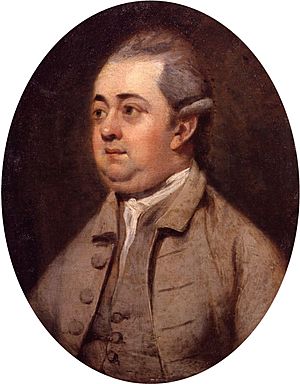The History of the Decline and Fall of the Roman Empire facts for kids
| Author | Edward Gibbon |
|---|---|
| Country | England |
| Language | English |
| Subject | History of the Roman Empire and Fall of the Western Roman Empire |
| Publisher | Strahan & Cadell, London |
|
Publication date
|
1776–1789 |
| Media type | |
| LC Class | DG311 |
The History of the Decline and Fall of the Roman Empire is a famous book series. It was written by an English historian named Edward Gibbon. The series has six books in total.
These books cover a very long period of history. They start from the year 98 AD and go all the way to 1590 AD. Gibbon writes about the strongest time of the Roman Empire. He also covers the early days of early Christianity. He explains how Christianity became the main religion of the Roman state. The books also tell the story of the Fall of the Western Roman Empire. They even talk about the rise of leaders like Genghis Khan and Tamerlane. Finally, they discuss the fall of the Byzantine Empire. Gibbon also shares his thoughts on the old buildings and ruins of Ancient Rome.
The first book came out in 1776. It was so popular that it was printed six times! The second and third books were published in 1781. The last three books (volumes four, five, and six) came out between 1788 and 1789. Back then, books were often printed in large sections called "quarto."
Contents
How the Book Was Made
Edward Gibbon first planned to write about the fall of the city of Rome. But he soon decided to write about the entire Roman Empire. This made his project much bigger.
Gibbon spent a huge part of his life working on this book. He worked on it from 1772 to 1789. He wrote about this in his own book, Memoirs of My Life and Writings. He felt that writing The History of the Decline and Fall of the Roman Empire became his whole life. He even compared publishing each new book to having a new child.
To write his history, Gibbon used ideas from other famous thinkers. He read books by Montesquieu, Voltaire, and Bossuet. These writers also explored history and how societies change.
What Gibbon Believed
Gibbon tried to explain why the Roman Empire fell. This was a hard job because many old records were missing.
Gibbon thought the Roman Empire became weak because its citizens lost their "civic virtue." This means people cared less about their community and more about themselves. This made the empire easier for barbarian groups to invade.
He also discussed the role of Christianity in the empire's decline. This idea caused a lot of debate. However, Gibbon also believed other things led to Rome's fall. These included problems inside the empire and attacks from outside groups.
Gibbon, like other thinkers of his time, saw the Middle Ages as a "Dark Age." He believed it was a time when superstition was more important than reason. He thought that true progress in human history only started again in his own era, the "Age of Reason." This was a time when people focused on logical thinking.
Gibbon's Writing Style
Gibbon wrote in a very clear and formal way. He tried to be fair and not show too much emotion. Sometimes, he would share his own moral lessons or wise sayings.
How the Book Lives On
Gibbon's book has had a huge impact on many writers. Many have used similar titles, like "Rise and Fall," for their own works. These often describe the history of large groups or empires.
For example, Jefferson Davis wrote about the "Rise and Fall of the Confederate Government." William Shirer wrote about "The Rise and Fall of the Third Reich." Even musician David Bowie had an album called "The Rise and Fall of Ziggy Stardust."
The book and its author are also mentioned in poems. Noël Coward's poem "I Went to a Marvellous Party" talks about Gibbon's book. The science fiction writer Isaac Asimov also mentioned Gibbon. Asimov said his "Foundation series" was inspired by Gibbon's work. Asimov's series is about the fall and rebuilding of a galactic empire.
One writer, Piers Brendon, said Gibbon's book helped Britons understand their own empire. He felt that by studying Rome's fall, they could learn about the future of the British Empire.
Even a punk musician, Iggy Pop, wrote about Gibbon's book. In 1995, he wrote an article called Caesar Lives. He said that "America is Rome." He believed that by studying ancient Rome, we can learn a lot about how our own society works today.
See also
 In Spanish: Historia de la decadencia y caída del Imperio romano para niños
In Spanish: Historia de la decadencia y caída del Imperio romano para niños


